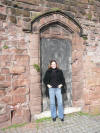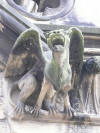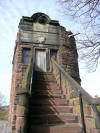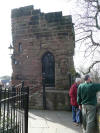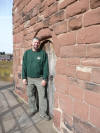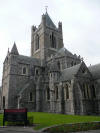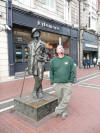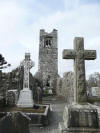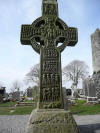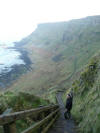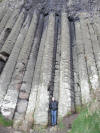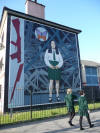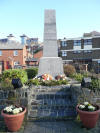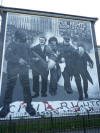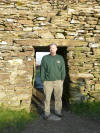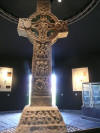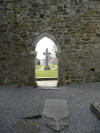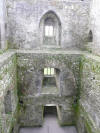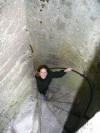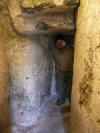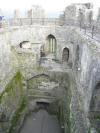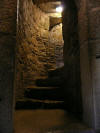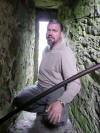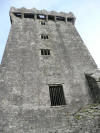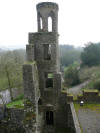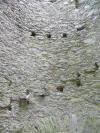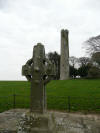Diary/Photo Journal
Week of March
15, 2009
(Warning: I recommend that you be drinking a cup o' tea or a
pint while reading this page as it was a long, incredible, photo-filled week -
enjoy!)
IRELAND!
Or what I like to call
"AHHHRELAND".
With the exception of Sunday, this week
was spent on the Emerald Isle, walking the paths of Leprechauns and Giants,
traveling through the Stone Age and into the Modern Age and standing on the
cliffs and rocks of history. Unlike the United States wherein you can
drive for hours before touching something of historical significance, you only
have to take a few steps in Ireland and you are likely to trip over some
monument, whether natural or man-made, that holds memories of an age past.
But first, a quick mention about our
Sunday in Chester, England. We spent this day with my cousins, Chris and
Adrian, and we enjoyed every minute of our tour through the countryside.
Chester is considered one of the most beautiful cities in Britain and I can
concur with that sentiment. What makes this city so unique is that it is
ringed by an almost continuous red sandstone wall that was built by the Romans
almost 2,000 years ago.
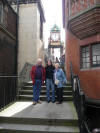 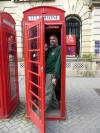 |
Adrian, Louise and Chris
in Chester, EnglandOld fashioned cell phone |
 
 
|
Gerson dodging traffic
Romans built the red sandstone wall almost
2,000 years ago
The wishing steps - you make a wish, hold
your breath and if you can run up and down
the stairs in that breath, your wish will come true
Adrian, Chris, Gerson and Louise in a
nice little pub called the Albion Inn |
Encased in this gi-normous (a word that I
learned from Adrian) wall, is a collection of Victorian and Tudor buildings that
keep your eyes wandering upward while your feet are propelling you forward
(hence, tripping can be a common occurrence). And, to top the wonders of
the day off, we had glorious sunshine the entire day.
We completed the wall circuit and the wealth of
interesting architecture was seemingly endless. People were also in
abundance as the sunshine seemed to not only bring out the daffodils, but the
locals as well.
Starting the week so nicely, we did not
think it could get much better, but oh how it did! First thing Monday
morning, we were off too Holyhead, Wales, our jumping off point via ferry to
Dublin, Ireland.
As we were to arrive in Dublin on the
afternoon of the 16th of March, we knew that the city would be in the birthing
stages of a rather raucous 24 hours (IE: St. Patrick's Day celebration) so we
opted to spend a short stint in Dublin and whisk northward and away from the
craziness (yes, we are getting old).
We hastened around Dublin proper and
visited the notable cathedrals, churches and castles and basically just took in
the "feel" of Dublin. I lost count of the many languages that I heard
being spoken and watching the people was almost as interesting as looking at the
architecture.
As we had many things that we wanted to
see and do in Ireland, we soon made our way to Northern Ireland. The
island is separated into two countries: Northern Ireland (a country within
the United Kingdom) and the Republic of Ireland (separate country onto
themselves). Northern Ireland is on the British pound currency and the
Republic of Ireland, or what many just refer to as 'Ireland", is on the Euro
currency.
We found a quaint little town called Slane
to stay in for our jumping off point into Northern Ireland. We stayed at
this wonderful little Bed and Breakfast (B&B) and even though the owners said
they were closed for the winter season, they recognized a business opportunity
and happily welcomed us into their home.
We got an early start as we had a
lengthy list of things we wanted to do. Starting off just south of Slane,
we toured Newgrange, a flattened, grass-covered mound that protects a fine Stone
Age passage tomb and an extraordinary prehistoric site that dates from around
3200 BC. This site predates the pyramids in Egypt by six centuries and it
appears to have been built as a special burial place for important people.
The tomb ceiling was constructed in such a
way that it catches the winter solstice sun and illuminates the entire chamber.
Large boulders referred to as "kerbstones" hold the structure together and many
are decorated with symbols and designs that represented something of importance
to people from a time long ago.
We silently crouched and crawled into the
large manmade cavern and soaked in the realization that not a drop of water has
leaked into this structure built over 5,000 years ago by people that only had
stone tools with which to complete the work.
From the south to the north, we ventured
up to the "Hill of Slane" to visit a breathtaking ruin of a church and tower
associated with St. Erc. The area is known for its beautiful Celtic
crosses and its intact tower. As the roof and floor structures have long
ago collapsed, the stone walls and stairs still provided the frame for the grand
building that was once there.
After our solemn visit to the Hill of
Slane, we continued northward with the intent to get to the Giant's Causeway
before they closed. However, a rather lengthy wrong turn kept us from our
goal for that day and we settled for a romp along the cliff's edge near to the
causeway coast.
We found a nice little B&B along the coast
and settled in for the night. While spending some quiet time in the pub
downstairs, I was helped to organize my photos by a rather curious urchin named
Oliver.
This adorable, pretentious five-year-old
was all blonde hair, blue-eyed innocence that had me laughing at just about
every comment he made. Just a bundle of energy and curiosity, he kept me
quite entertained. However, that amusement eventually turned to shock when
the following conversation emerged. (Please keep in mind, the struggles
and the "Troubles" that have plagued Northern Ireland are entrenched in
the psyches
of the previous generations).
While discussing girls and what would he
do if they chased him and caught him (as he was so cute), he responded he would
just "kick and hit them". When I responded that you should not "kick and
hit" anyone and especially not girls, he just casually said that he was learning
to fight so he could kick and hit the "bad police". I then asked why would
he want to "kick and hit" the police and Oliver stated rather aggressively that
the "police were bad" and that they "took the guns away" and that the "police
should all get kicked and beaten up" because "they were all bad".
With Oliver's Father and what I assumed to
be his Grandparents at the bar nearby, I tried to not show my astonishment too
openly in either expression or voice. I attempted to change the subject by
asking what Oliver did in school and he stated matter-of-factly, "I don't need
school to kick the police". Fortunately, Oliver walked away to get
something to drink and gave me a chance to restore my composure.
To hear such venom, such violent hatred
coming from a five-year-old's mouth only reminded me of how influential we are
to "our" children and how adult hatred and adult zealous opinions should remain
within the adult community. Oliver has no idea why he hates the police or
why he would "kick and hit" girls, he just knows that that was acceptable
behavior for (probably) a family member so therefore, it is acceptable for him.
How sad, how very, very sad.
The Giant's Causeway - an enormously
beautiful place, a huge spectacle of hexagonal pillars, a magnificent example of
the wonders of geology, all confined to this northern coastal edge (and shared
by the southern outlying islands of Scotland, just across the Channel).
The Giant's Causeway was formed 60 million
years ago when molten basaltic lava flowed into the existing chalk beds.
The lava cooled and hardened from the top and bottom surfaces inward, thus
contracting and creating a pattern of hexagonal cracks at right angles to the
cooling surfaces. Erosion eventually made its way into the lava flow and
the basalt split along the contraction cracks, creating the fascinating
hexagonal columns.
Since I have explained to you the
"scientific" reason (yawn) for the exceptional hexagonal structures seen along this
"causeway", I will share with you the other, more colorful explanation
for this seemingly supernatural compilation of stones.
Once upon a time, the Irish Giant,
Finn MacCool, wanted to cross the sea so he could fight the Scottish giant
Benandonner. He built the Causeway across the body of water and when he
stepped across and saw that his enemy was far bigger than he, he fled back to
Ireland. Soon thereafter, Finn's wife heard the angry Brenandonner come
lumbering across the Causeway and being the clever woman that she was, devised a
plan wherein she dressed her husband in a baby's shawl and bonnet and curled him
up in a crib.
When the Scottish giant met Mrs.
MacCool, he was strongly told to not disturb her baby. Upon realizing that
if this huge baby was Finn MacCool's child, then MacCool himself must be
enormous and the Scottish giant thundered back to Scotland, tearing up the
Causeway as he went. All
that remains are its ends located at the Giant's Causeway in Northern Ireland
and the coast of the island of Staffa in Scotland.
Now, isn't that a much better explanation!
We spent a few hours and covered many
kilometers along the Giant's Causeway and it seemed that there was some amazing
view or geologic wonder at every turn. The actual Causeway is a paradise
playground as you just cannot resist leaping, jumping, hopping and skipping
between the hexagonal pillars that spread out in all directions.
If walking among the giants was not enough
for the day, we decided to drink among them as well. As we needed a bit of
refreshment, we decided to visit the local whiskey distillery and take their
tour on the making of Bushmills Whiskey.
Bushmills is named for the village where
the whiskey has been made since 1608 and at the end of the tour, we were able to
taste a few different whiskeys, or should I say, Gerson got to drink my samples.
All in all, it was a terrific tour (and according to Gerson, very good whiskey).
As though we had not done enough already,
we made our way over to the Carrick-a-Rede Rope Bridge. This "bridge" is a
20 meter (about 60 feet) long wire rope and wood strip bridge between the sea
cliffs and the island, Carrick-a-Rede, and is about 30 meters (90 feet) above
the crashing ocean below. As the island has been a base for salmon fishing
for the past 200 years, the fishermen would build this bridge every Spring and
then would stretch their nets below to intercept the westward migrating salmon.
Believe it or not, at this point in the
day we were only in the early afternoon and we had plenty of time for even more
sightseeing fun. We pointed our car westward and we headed over to Derry or Londonderry or
Derry/Londonderry or...
There is a reason for the confusing name(s)
of this city, and like much in Ireland, little sense can be made why there still
is an issue. Derry was the city's original "anglicised" name and in the
1600's when the Corporation of London infiltrated the city with Protestant
settlers. Hence they determined the city should then be called
"Londonderry". However, with the Irish being, well, "Irish", they refused
the new name and continued to refer to their beloved town as "Derry".
Flash forward over 200 years later and the
name of the city is still an issue between the differing factions within
Ireland. The "London" part of the name is often defaced on signs and
referring to "Derry" infuriates London supporters (insert shaking head here).
So, in order to keep the peace in this part of the country that is seething with
anger just below the fingernails, the city is referred to as
'Derry-stroke-Londonderry' or 'Derry/Londonderry'. Unfortunately, a
permanent change back to the more commonly used "Derry" can only be done by the
Queen on the recommendation of the government (and that is about as likely as
Ireland becoming one country again).
We drove along narrow roads through some
gorgeous country that intercepted the coast and the green hills as we made our
way to Derry. As we did not have as much time as we would have liked, we
decided to center on the historic area of Bogside (fortunately, they left that
name alone).
Bogside contains famous murals painted by
local artists that depict key events in the "Troubles", including the Battle of
Bogside, Bloody Sunday and the 1981 hunger strike. These illustrations are
painted on the sides of multi-story buildings and one cannot walk past without
being halted in mid-step at the sight of the telling images.
The most chilling mural is called "The
Death of Innocence", which portrays the stunning figure of the 14-year-old
schoolgirl, Annette McGavigan, the 100th victim of the Troubles, who was caught
in the crossfire between the IRA and the British Army on September 6, 1971.
The description of the mural is also shown in my photos, and because I feel it
is a must read, I will repeat it here:
Here the innocence of a child's
world contrasts vividly with the chaotic violence with which others have
surrounded her. The mural commemorates fourteen year old Annette McGavigan
who was shot by a British soldier in 1971, the 100th victim of the Troubles and
one of the first children to be killed. The little coloured stones at her
feet are objects she was collecting for a school project. The broken gun
signals a call for an end to violence. The butterfly and the crucifix are
symbols of innocence and rebirth. Annette stands for all the children who
have died through violence during the Troubles.
Our challenge was to take such a
heart-rending event as the brutal death of a young girl and make it a plea for
peace and sanity.
Bloody Sunday occurred on January 30,
1972, when 20,000 civilians marched through Derry in protest against internment
without trial. History has clarified that British soldiers fired upon the
unarmed crowd, killing fourteen people (some shot in the back). At this
time, none of the soldiers that fired the 108 bullets nor the officers in charge
have been brought to trial or even disciplined and mysteriously, records have
disappeared and weapons have been destroyed.
From the somber site of Bogside, we walked
the walls that surround the original city (much like Chester, although not as
pretty as modern Irish architects leave a lot to be desired) and took
some time to visit St. Columb's Cathedral. Built around 1630, it is the
oldest building to survive.
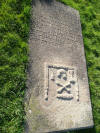 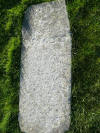 |
Some very old grave stones
It is rare to see the skull and
crossbones on a grave
The date on the second is 1639!
|
 
 |
St. Columb's Cathedral - circa 1630
View down wall surrounding Derry
Daffodils are in bloom and provide
a colorful foreground for this pleasant
street |
As we had just a bit of daylight left to
enjoy, we pushed on westward and caught the last bit of sun over Grianan of
Aileach, an amphitheatre-like stone fort thought to have been built over 2,000
years ago. Gerson wandered around the parapet walls and I took in the
marvelous views of the countryside.
With the sun setting, we thought it was a
good time to finish our insightful day and we found a wonderful B&B in a quaint
little town called Dunfanaghy (I will let you try and pronounce that one).
With a typical full Irish breakfast
devoured (cereal, toast, eggs, bacon, sausage, mushroom, tomato, beans, coffee,
juice, milk and any combination thereof), we headed off for what was to be a
short drive around "Horn Head" just outside of Dunfanaghy. What we did not
know was that this peninsula drive was so stunning that we ended up spending
almost two hours tottering up the single track lanes and walking wind-blasted
cliffs.
Once we extricated ourselves from the
beauty of Horn Head, we found ourselves in equally wondrous landscape as we
tooled down the west coast of the island, finding any excuse to divert to roads
hugging the shoreline.
Even though this day was filled mostly
with road meandering, we found the time flew by quickly. We could not have
asked for a better touring day as the sun was brilliantly exposing the
countryside and as it was the end of winter, we had very little company on the
roads. We passed by cozy villages and of course, the occasional castle and
quaint cottage.
We decided to check out a small enclave
outside of Sligo called Strandhill, that we heard was known for its year-round
surf and we were not disappointed. We rolled into this superb corner just
at sunset and found the waters speckled with neoprened surfers. As you
will see by the pictures, the waves were respectable as were the surfers
themselves. Our B&B was not too shabby either.
Outside of Strandhill is an exceptional
windswept mountaintop site that was sacred in prehistoric times.
Carrowkeel Passage Tomb Cemetery has been dated to the late Stone Age (around
3000 - 2000 BC) and is a series of relatively intact mounds and passage tombs.
Again, like the Newgate tomb, these tombs are still bone-dry inside (pun
intended)..
In addition to being reminded of the Stone
Age, we also visited another age, an age of great tragedy in the history of
mankind: the great potato famine. In the 1840's, the main sustenance (both
nutritionally and financially) for
the impoverished people was the potato and a devastating fungus devoured the
great majority of the potato crop. As a result, people were starved of
food and money (as their source of income also shriveled up) and many were
forced to emigrate with little or nothing with which to start their new lives.
Also, many of the emigrants that were
either forced off their leased farmlands or left to find work elsewhere, died in
route to their new homes and thus the potato famine exposed a chapter in human
behavior that exemplified how ignorance, callousness and cruelty of one human to
another can create a stamp in history that can never be erased.
 
 
|
Carrowkeel Passage Tomb Cemetery
I would say the dead did not mind
being squeezed in some of these tombs
Look closely at the third picture -
can you see Louise?
View from Carrowkeel |
 
 
|
Inside a passage tomb
Strokestown Park House where
the famine museum is housed
(this was the estate of one of the
families that forced the emigration
of some 1000 famine victims, 600
of them to their death)
Gerson calls the last picture
"lunch"....mmmmm |
Well, we obviously did not have enough
death and tragedy as we were off to yet another ruin and graveyard that dates
back to AD 548 (although most of the ruins are remnants from the 10th through
12th centuries). The Clonmacnoise was one of Ireland's most important
monastic cities and contains numerous churches, high crosses, towers and graves
in astonishingly good condition.
Between the 7th and 12th centuries, monks
from all over Europe came to study and pray at Clonmacnoise, hence Ireland
becoming known as the 'land of saints and scholars'.
Making the most of the sunshine (we are
now on our third straight day without rain in Ireland and that is saying
something), we kept moving along the coast and into the good-sized city of
Galway. Galway is known as a "walkable city" and it definitely is easily
traveled by foot. Having been around since the 1300's, Galway has a
distinctive mesh of old and new architecture that somehow works and is very
pleasing to the eye.
The terrific day brought out swarms of
people along the streets and the river and the outdoor cafes were brimming with
chatty customers. We enjoyed our lunch in a quirky little Mexican
restaurant and went for a leisurely stroll down the lanes and along the river.
As Galway was not to be our resting place for that evening, we ventured on in
hopes of reaching a place called "The Burren".
As the weather and the traffic were both
kind to us, we made it into The Burren, a west coast peninsula across the bay
from Galway (the Galway Bay to be exact) just before the sun completely closed
out our day. In a way, the lack of lighting made the area a bit more
compelling and our destination, the Cliffs of Moher, rather nerve wracking.
The Burren was so named for "Boireann"
which means 'rocky place'. Appropriately named as the area has a unique
limestone landscape that was thrust upward and out of the sea during a long ago
geological event. A result of this fantastic geology are the Cliffs of
Moher which stand proud to a height of over 200 meters (about 600 feet) out of
the thrashing sea. The Cliffs are entirely vertical and when walking along
the edges of the rock formations, there was no margin for trekking error.
To give you an idea about the abruptness
and the vertigo-inducing capability of these cliffs, Gerson surprisingly got a
little woozy when he stepped out onto the rock platform within feet of the edge
and was watching me get even closer. In all the time we have traveled and
to all the places we have been, I have never seen Gerson waiver at anything,
high or low, steep or flat. When he told me that he was not feeling quite
right and my seeing his face go a bit ashen, we both realized he was having a
bit of a spell because of the sheerness and the height of the cliffs (and his
concern over me :-)). A few moments away from the edge and he was fine
thereafter, but what an unexpected reaction!
Of course I continued to frolic near the
edge and Gerson was good enough to capture a few of these moments on the camera.
I know it may seem embarrassing to Gerson that he got taken aback by the
ferocity of the sheer walls; however, it just goes to show you how unnerving the
lighting and the abruptness of these cliffs were at the time. I was
probably just too daft to realize it.
Having thought we put the fearsome sights
behind us, we did not count on the experience of driving the narrow road in the
dark. Soon after leaving the Cliffs of Moher, we were enthusiastically
looking for a place to stay for the night. With some of those roads, I
would have preferred to sleep on the cliffs!
We managed to find a nice place to stay
soon enough and with sunlight greeting us again in the morning (we are now going
on four straight days), we were off to the mythical Blarney Castle. The Blarney
Castle was built in the 15th century and is remarkable in and of itself by its
construction and its situation atop a hill overlooking beautiful grounds.
But, that is not what attracts the throngs of visitors to the Blarney Castle,
but rather it is the attraction to one particular stone that we were so enamored
of, that we bent over backwards to kiss it.
Yes, we kissed the Blarney Stone!
The custom of kissing the stone is a
relatively newer one, dating back a little beyond 200 years. The idea is
that once you have kissed the Blarney Stone, you will be granted the gift of
eloquence (or perhaps, the gift of pontification). I told Gerson that I
was kissing the stone so I could give some of that ability back (it did not
work, I still talk as much as ever). Here is the explanation
of how the term "blarney" entered the English language:
Queen Elizabeth I is credited with introducing the word
"blarney" to the English language. Her emissary, Sir George Carew, was
charged with persuading the MacCarthy chieftain (Lord Blarney) to abandon his
ancient rights and to accept the authority of the English throne. Every
time he tried, he was met with long and eloquent protestations of loyalty and
honeyed flattery of the Queen - but with no agreement.
In frustration, Elizabeth exclaimed, "This is all Blarney,
what he says he never means." And a new word was born.
Another little tidbit about the stone is
that it was thought that the stone was Jacob's Pillow, brought to Ireland by the
Prophet Jeremiah. Here it becomes the Lia Fail or 'Fatal Stone', used as
an oracular throne of Irish kings - a kind of "Harry Potter sorting hat" for
kings. Legend says it was then removed to Scotland, where it served as the
prophetic power of royal succession, the Stone of Destiny.
When Cormac MacCarthy sent four thousand
men to support Robert the Bruce in his defeat of the English at Bannockburn in
1314, the Stone was split in half and half was sent to Blarney. Some years
later, a witch was saved from drowning revealed its powers to the MacCarthys.
We spent quite a bit of time at the
Blarney Castle as it was quite a grand place. We were fortunate to be
there with only a few other visitors so we really had the opportunity to crawl
around the nooks and crannies and to enjoy some of the vistas from the parapet.
After all this stone-kissing and eloquent
conversation, we hurried northward to the Rock of Cashel. The Rock of
Cashel is a clutch of historical religious buildings that seem emerge from the
rocky landscape that surrounds it. Limestone outcroppings ring the site
and it has existed for more than 1000 years. And no, we never seem to tire
from looking at these magnificent historical structures and their artistic
treasures.
Fortunately, some of the interior artwork
has been salvaged and is being protected and restored. Quietly walking
through this ruin leaves you with a sense of awe at how large the site truly is
and how much was sacrificed to bring this religious stronghold about.
 
 |
View to the Hore Abbey
(circa 12th century)No one alive knows who
this
face belonged to
Restoring a fresco found within
the peeling plaster |
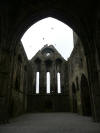 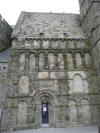 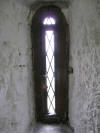 |
Crows and a ruined
Cathedral, eerieNotice the stone roof,
not slate, but stone
blocks
Ornate and beautiful
window |
Hunger overtook us and we found a nice
little lunch place down the road. As we were on our fifth day of no rain
(must be a record in Ireland), we were pushing to get to the east coast for the
night. Of course, we still intended to see just about every castle, tower,
graveyard, etc. along the way.
As we were leaving the Emerald Isle the
next day, we sprinted our last leg across the southern hills of the Republic of
Ireland and into Rosslare for the night. As we have now gone nine days
without rain, we are quite pleased with our trip thus far (or rather, we are
over the moon and back again with our good fortune!).
 |
Just one of our road view in Ireland |
 |
A magnificent sunset to cap off a
superlative week |
Home Page
United Kingdom Diary Index
Previous Diary Page 2
UK Diary Page 4






